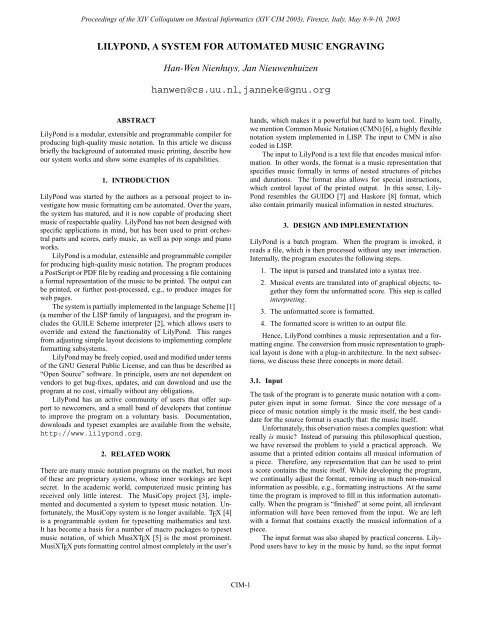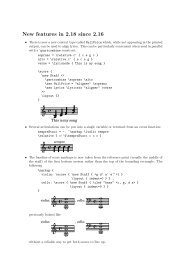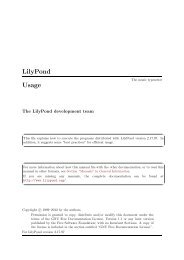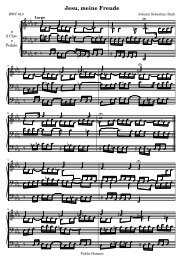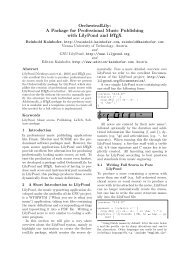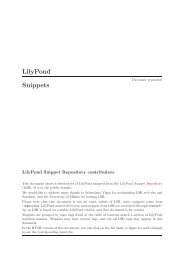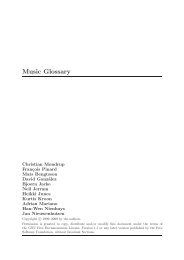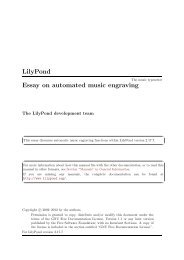Lilypond, a system for automated music engraving - CiteSeerX
Lilypond, a system for automated music engraving - CiteSeerX
Lilypond, a system for automated music engraving - CiteSeerX
Create successful ePaper yourself
Turn your PDF publications into a flip-book with our unique Google optimized e-Paper software.
Proceedings of the XIV Colloquium on Musical In<strong>for</strong>matics (XIV CIM 2003), Firenze, Italy, May 8-9-10, 2003Figure 3: The input <strong>for</strong>mat shown in an XML <strong>for</strong>mat. This outputis generated directly from the parse tree of the example in Figure 1using a short (100 line) Scheme function.3.3. LayoutThe product of the interpretation step is a collection of graphicalobjects, the un<strong>for</strong>matted score. Each <strong>music</strong>al symbol in the scoreis represented by a graphical object. Relationships such as containment,alignment, or element spacing are also represented byabstract graphical objects. Figure 4 shows a simplified version 1 ofthe un<strong>for</strong>matted score <strong>for</strong> the example of Figure 1.Objects contain variables that describe properties of the boject.These variables (object properties) are used in the <strong>for</strong>mattingprocess in many ways.• Global style settings are stored in properties. All objectsshare a global defaults, <strong>for</strong> properties. For example, theglobal default <strong>for</strong> beam objects has a property thickness,which is set to 0.48 staff space.• Formatting adjustments are also stored in properties. Astem can be <strong>for</strong>ced up by entering a simple command inthe input file. This command adds direction=UP to thedefinition of a stem object.• Properties containing subroutines define <strong>for</strong>matting proceduresand other behavior of graphical objects. For example,in Figure 4, the height of the container object is given bya function group-height, stored in the property height.These functions may be replaced by user-written Schemecode.• Objects can refer to each other. For example, the stem andnote head objects have note-head and stem propertiespointing to each other.1 The example in Figure 4 has been highly simplified. In LilyPond version1.7.1, the file shown actually is translated into 33 different graphicalobjects. The line breaking process multiplies this to 59 objects, most ofwhich are abstract.obj 1: glyph-name="treble"obj 2: glyph-name="fourfour"obj 3: obj 4:position=-6line-thickness=0.12stem=→obj 4 note-head=→obj 3obj 5: obj 6:position=-5line-thickness=0.12stem=→obj 6 note-head=→obj 5obj 7:obj 8: containerline-count=5elements=staff-space=1.0 →obj 1,..., →obj 7line-thickness=0.1 height=group-heightFigure 4: Graphical objects from the un<strong>for</strong>matted score <strong>for</strong> Figure1. Each object stores style and layout settings in variables.These variables are generic, and can contain any type of object,including numbers, strings, lists, procedures and pointers to otherobjects. obj 8 is “abstract,” i.e. it does not produce output.Object properties are stored in Scheme data structures, and can bemanipulated in user-written code.In the <strong>for</strong>matting step, spacing and line breaks are determined,and layout details of objects are computed. For example, stem objectsnormally do not have a predefined length. During the <strong>for</strong>mattingprocess, a length is computed and filled into a length property.The result of the <strong>for</strong>matting step is a finished score, which iswritten to disk. A helper program post-processes the output to addpage breaks and titling, and produces a ready-to-view PostScriptor PDF file. LilyPond by default outputs the notation in a TEX file,but other output <strong>for</strong>mats are also available: there is experimentalsupport <strong>for</strong> SVG and direct PostScript output.4. EXAMPLESSince none of the freely available fonts satisfied our quality demands,we have created a new <strong>music</strong>al font, called “Feta”, basedon printouts of fine hand-engraved <strong>music</strong>. A few notable aspectsof Feta are shown in Figure 5. The half-notehead is not ellipticbut slightly diamond shaped. The vertical stem of a flat symbol isslightly brushed: it becomes wider at the top. Fine endings, suchas the bottom of the quarter rest, do not end in sharp points, butrather in rounded shapes. Taken together, the blackness of the fontis carefully tuned together with the thickness of lines, beams andslurs to give a strong yet balanced overall impression.The spacing of a piece of <strong>music</strong> should reflect the character ofthe <strong>music</strong>. A piece should not contain unnatural clusters of blacknor big gaps with white space. The distances between notes shouldreflect the durations between notes, but adhering with mathematicalprecision to durations will lead to a poor result: the eye notonly notices the distance between note heads, but also betweenCIM-3
Proceedings of the XIV Colloquium on Musical In<strong>for</strong>matics (XIV CIM 2003), Firenze, Italy, May 8-9-10, 2003♭ We study engraved editions as a guide when implementing <strong>for</strong>mattingalgorithms. The most recent revisions of the the beamingand spacing code were guided by the Bärenreiter edition of theCello Suites by J. S. Bach [12], in particular, measurements ofthe Sarabande of the second suite guided our current spacing algorithms.Figure 9 shows our rendering of this piece. LilyPond’sFigure 5: Three glyphs from the Feta font.default decisions <strong>for</strong> stemming, spacing and line breaking followthe printed edition, except in two places, where manual overrideof the layout was necessary. The layout quality of this piece is comparable with the original hand-engraved edition.The best quality print-outs are attained <strong>for</strong> single staff, singlevoice <strong>music</strong>. Nevertheless, multiple staffs and polyphonic notationare also supported. Conflicts in notehead placement (collisions) between polyphonic voices are resolved automatically if possible. Figure 7 shows some some collisions in the context of piano <strong>music</strong>.LilyPond is not limited to classical <strong>music</strong>. There is also support <strong>for</strong>chord names, tablature, figured bass and medieval notation.Figure 6: A fragment demonstrating spacing. The top fragmentis printed with optical spacing. In the bottom fragment, all noteheads are at equal horizontal distances. As a result, the downstem/upstemnote pairs <strong>for</strong>m visual clumps.consecutive stems. There<strong>for</strong>e, the notes of a up-stem/down-stemcombination should be put farther apart, and the notes of a downupcombination should be put closer together, all depending on thecombined vertical positions of the notes [9]. Figure 6 demonstratesthis optical spacing.In engraved <strong>music</strong>, beams should cover staff lines as much aspossible. This prevents small distracting wedges of white space,and uneven appearance of the beam thickness. In Finale, suchbeams are known as “Patterson beams” after the plug-in that offersthis functionality. We call this beam quantization, as the verticalpositions of the beam end-points are not continuously variable, butdiscrete. LilyPond also offers beam quantization. It uses a genericmechanism, where a large number of configurations <strong>for</strong> both beamendings are tested. For every configuration a penalty score is computed.For example, configurations that lead to very short stemsincur a heavy penalty, and very long stems a small penalty. Similarly,a penalty is computed <strong>for</strong> the slope of a configuration, and <strong>for</strong>positions that lead to “<strong>for</strong>bidden” positions of secondary and tertiarybeams. A weighted sum of the penalties measures the beautyof a configuration. After computing penalties <strong>for</strong> all configurations,the best scoring configuration is used as beam position. Thisapproach is independent of the number of stems (Ross [10] listsmany examples <strong>for</strong> beams with two stems, but gives no furtherrules), and adapts to different beam thicknesses. In addition, ifmore complex rules are needed, these can be integrated by addingmore scoring functions to the code.Some <strong>for</strong>matting procedures are based on other work. For example,Hegazy and Gourlay [11] describe a line breaking approachsimilar to TEX’s line-breaking algorithm. This algorithm has beenre-implemented <strong>for</strong> LilyPond. The spacing engine describes thedesired spacing in terms of springs. When justifying a single line,<strong>for</strong>ce is needed to compress or stretch these springs. Very looselyand very tightly spaced lines require more <strong>for</strong>ce. A dynamic programmingalgorithm is used to find the configuration of line-breaksthat keeps the total <strong>for</strong>ce as low as possible. This results in a set ofline breaks that favors even and natural spacing across the entirepiece. ♭♭♭ ♭ 48 3 ♭ ♭ ♭4848̇ ♮ ♯♯♮♯♮♯ ♮ ̇̇♮ ♯ ♮♮Figure 7: Random complex polyphonic notation. The lower leftbeam uses French beaming and different stem and beam thicknessesbut its position is still quantized correctly.The design of the program en<strong>for</strong>ces a strict separation betweencontent (<strong>music</strong>) and <strong>for</strong>m (typography). A consequence is that thesame piece <strong>music</strong> may be represented in different <strong>for</strong>ms. Chords<strong>for</strong>m simple example. In the following fragment, a chord is enteredusing the syntax >. That same chord is then printedboth in a staff and in textual <strong>for</strong>m.sus = \notes {4 }\score { \simultaneous {\context ChordNames \sus\context Staff \sus} } △/sus4CSeparation between <strong>for</strong>m and content is also used in the support<strong>for</strong> transcribing mensural <strong>music</strong>. Mensural <strong>music</strong> uses differentfont shapes <strong>for</strong> notes, clefs and alterations. In addition, particularrhythmical patterns of notes are denoted by combining theirnote heads in special symbols called mensural ligatures. LilyPonddoes not add a separate <strong>music</strong> representation <strong>for</strong> this type of <strong>music</strong>.Instead, the <strong>music</strong> is entered as if it were modern notation, andligatures are marked in the input. During print-out, a print style <strong>for</strong>mensural notation can be selected. Support <strong>for</strong> historic print stylesis included, and can be used to check the transcription to modernnotation. Figure 8 shows an example of this process. In effect,LilyPond transcribes from modern notation to mensural notation.As a consequence, there is a single input language representingboth mensural ligatures and their transcriptions into modern notation.The separation between content and <strong>for</strong>m is thereby maintained.Support <strong>for</strong> ligature notation is an experimental feature,CIM-4
Proceedings of the XIV Colloquium on Musical In<strong>for</strong>matics (XIV CIM 2003), Firenze, Italy, May 8-9-10, 2003and current work focuses on implementing the variety of printingstyles of Gregorian notation. ♭ ♭ ♯♯Figure 8: The same fragment of <strong>music</strong> in three ancient layoutstyles: historical print (top), contemporary mensural notation(middle), and modern notation with ligature brackets (bottom).Finally, this paper itself shows an application of LilyPond: textand <strong>music</strong> can easily be mixed in the same document. The input<strong>for</strong>mat is ASCII based, so one can enter snippets of LilyPond inputin other ASCII based document <strong>for</strong>mats, such as L A TEX and HTML.With the aid of a small helper program, these fragments can bereplaced in the output by the corresponding <strong>music</strong> notation, in the<strong>for</strong>m of pictures (<strong>for</strong> HTML) or TEX (<strong>for</strong> L A TEX). For example,Figure 1 was created by entering the following in the L A TEX sourcefile\begin[verbatim]{lilypond}\notes { c’4 d’8 }\end{lilypond}5. DISCUSSION AND FUTURE WORKWe have presented our progress on LilyPond, a free <strong>music</strong> <strong>engraving</strong><strong>system</strong>, which converts a <strong>music</strong> representation to high quality<strong>music</strong> typography. For some pieces, LilyPond output is comparableto hand-engraved <strong>music</strong>. The program is focused on producinghigh quality notation automatically. This makes it an excellenttool <strong>for</strong> users who are not notation experts.LilyPond can run without requiring keyboard or mouse input.This makes it an excellent candidate <strong>for</strong> generating <strong>music</strong> notationon the fly, e.g., on webservers. The degree of automation alsomakes it a suitable candidate <strong>for</strong> trans<strong>for</strong>ming large bodies of <strong>music</strong>to print automatically: <strong>for</strong> example, LilyPond has been used toproduce an <strong>automated</strong> rendering of a database of 3,500 folk songsstored in ABC [13]. This is helped by the fact that LilyPond includes(partial) convertors <strong>for</strong> a number of <strong>music</strong> <strong>for</strong>mats, amongothers MusicXML [14], MIDI, Finale’s ETF, and ABC.Beaming, line breaking and spacing are the strong points of the<strong>for</strong>matting engine. In some areas the engine still falls short. Forinstance, placing fingering indications, articulation and dynamicmarks together is a complex problem. We plan to improve collisionhandling such that manual adjustments are no longer necessary<strong>for</strong> complex configurations of these notation elements. Otherplans <strong>for</strong> future work include improving <strong>for</strong>matting of slurs andadding page layout to the <strong>system</strong>.The program has no graphical user interface, and always producesall pages of the final output. To see the result of a change, theprogram has to be rerun on the entire score. In effect, this trans<strong>for</strong>ms<strong>music</strong> editing into a debug-compile cycle, and fine-tuninglayout details is a slow process. We plan to explore solutions thatmake manual adjustments with LilyPond a more interactive andefficient process.6. ACKNOWLEDGEMENTSOur sincere thanks go out to all our developers, bug-reporters andusers; without them LilyPond would not have been possible. Inparticular, we would like to thank Jürgen Reuter <strong>for</strong> contributingligature support, and providing the mensural notation example <strong>for</strong>this paper.7. REFERENCES[1] “Revised 5 report on the algorithmic language scheme,”Higher-Order and Symbolic Computation, vol. 11, no. 1,September 1998.[2] Free Software Foundation, “GUILE, GNU’s UbiquitousIntelligent Language <strong>for</strong> Extension,” http://www.gnu.org/software/guile/, 2002.[3] Allen Parish, Wael A. Hegazy, John S. Gourlay, Dean K.Roush, and F. Javier Sola, “MusiCopy: An <strong>automated</strong> <strong>music</strong><strong>for</strong>matting <strong>system</strong>,” Tech. Rep., Department of Computerand In<strong>for</strong>mation Science, The Ohio State University, 1987.[4] Donald Knuth, The TEXbook, Addison-Wesley, 1987.[5] Daniel Taupin, Ross Mitchell, and Andreas Egler, “Musixtex,”2002.[6] Bill Schottstaedt, Beyond MIDI. The handbook of <strong>music</strong>alcodes, chapter Common Music Notation, MIT Press, 1997.[7] H. H. Hoos, K. A. Hamel, K. Renz, and J. Kilian, “TheGUIDO <strong>music</strong> notation <strong>for</strong>mat—a novel approach <strong>for</strong> adequatelyrepresenting score-level <strong>music</strong>,” in Proceedings ofInternational Computer Music Conference, 1998, pp. 451–454.[8] Paul Hudak, Tom Makucevich, Syam Gadde, and Bo Whong,“Haskore <strong>music</strong> notation—an algebra of <strong>music</strong>,” Journal ofFunctional Programming, 1996.[9] Helene Wanske, Musiknotation — Von der Syntax desNotenstichs zum EDV-gesteuerten Notensatz, Schott-Verlag,Mainz, 1988.[10] Ted Ross, Teach yourself the art of <strong>music</strong> <strong>engraving</strong> andprocessing, Hansen House, Miami, Florida, 1987.[11] Wael A. Hegazy and John S. Gourlay, “Optimal line breakingin <strong>music</strong>,” in Proceedings of the International Conferenceon Electronic Publishing, Document Manipulation andTypography. Nice (France), J. C. van Vliet, Ed. April 1988,Cambridge University Press.[12] Johann Sebastian Bach, Sechs Suiten für Violoncello solo,Number BA 320. Bärenreiter, 1950.[13] Erich Rickheit, “Yet another digital tradition page,” http://sniff.numachi.com/˜rickheit/dtrad/.[14] Guido Amoruso, “Xml2ly,” http://www.nongnu.org/xml2ly/.CIM-5
Proceedings of the XIV Colloquium on Musical In<strong>for</strong>matics (XIV CIM 2003), Firenze, Italy, May 8-9-10, 2003 ♭3434̇ ̇ ̇ ♯̇♮̇ ̇ ♭6̇̇̇̇ ̇̇ ̇11♭̇̇♭̇ ♯̇♭ ♯♭16♭̇ ̇ ̇♮♭♭♯ ♮ ♯ ̇ 21♭̇ ̇̇♯̇♯ ♮ ♯25♭ ♮ ̇♯̇♮♯♯̇̇ ♯̇Figure 9: Sarabande of the second Cello Suite by J.S.Bach, after the Bärenreiter edition [12]. This example had manual adjustments in twoplaces: the line break in the last line was <strong>for</strong>ced, as were the stem directions on the last beat of measure 24. In addition, this example hasbeen scaled by 80%, to fit in the <strong>for</strong>mat of this report.CIM-6


